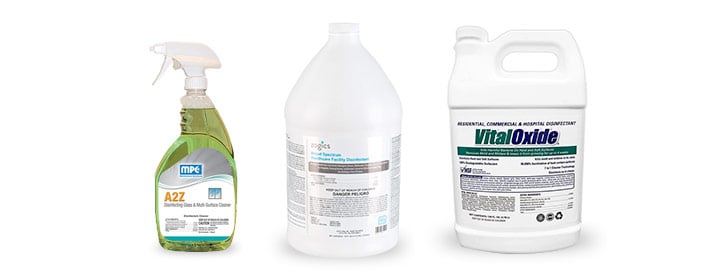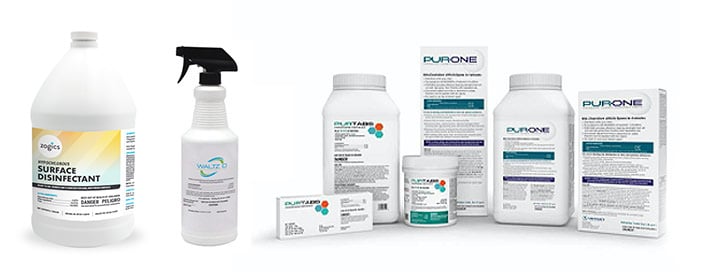Disinfectants 101: A Primer
Learn about the different types of commercial disinfectants, where to use them, and the differences between them.
First Things First: What Are Disinfectants?
Disinfectants are chemical agents applied to non-living objects in order to destroy bacteria, viruses, fungi, mildew or mold living on the objects. By definition, disinfectant formulas must be registered with the Environmental Protection Agency (EPA).
The active ingredient in each disinfectant chemistry destroys pathogens, typically by disrupting or damaging their cells. Active ingredients are usually aided by other ingredients in the disinfectant. As an example, surfactants can be added to a disinfectant formula to provide consistent wetting on a surface, or to help in cleaning.
Main Types of Disinfectants
Several broad categories of industrial-strength disinfectants are used in commercial and industrial facility maintenance. Below are some of the most common types. While not an exhaustive list, these cover the large majority used today, and the types of commercial disinfectants we offer.

1. Quaternary Ammonium Compounds (a.k.a. Quats)
A top choice for disinfection in hospital and institutional settings because of their low cost and quick action against a wide range of pathogens and microorganisms, Quats can be formulated with a variety of detergents to provide both cleaning and disinfecting ability. A2Z and Vital Oxide are examples of quat-based disinfectants with both cleaning power and broad-spectrum kill claims for many common and dangerous bacteria and viruses, including SARS-CoV-2, the virus that causes COVID-19.

2. Hypochlorous Acid
Hypochlorous Acid (HOCL) was discovered centuries ago as a germ-killing agent. HOCL is created by combining water and salt through a patent-pending electrolyzing process. This makes an oxidized, antimicrobial solution capable of killing many pathogens in a variety of environments. Not only does HOCL disinfect surfaces quickly and safely, it also sanitizes and deodorizes. Hypochlorous Acid Disinfectant is an example of a HOCL disinfectant, ideal for use in healthcare settings and food preparation processing.
We also offer EvaClean's PURTABS and PUR:ONE; the active agent for both of these commercial disinfectants is sodium dichloroisocyanurate (shortened to NaDCC), which when dissolved in water creates HOCL.

3. Gycol Ether Solvents
When diluted in water, ether solvents are effective against a wide range of bacteria, though higher concentrations are often needed to disinfect wet surfaces. The downsides? They evaporate quickly (and therefore may not remain on the surface long enough to kill), they’re flammable, and they may not have organic soil tolerance claims, meaning they may not be effective when organic matter (blood, for example) is present in the area being disinfected. Most often, you'll see alcohol-based disinfectants in use as wet wipes or sprays. We offer ready-to-use alcohol disinfectants that provide you with ample coverage to wipe down and sanitize almost any surface. The isopropyl-alcohol formula is gentle and effective, quick to evaporate, and safe to use on solid objects and surfaces, such as plastic, laminates, metals, glass, plexiglass screens, and rubber.
What to Consider When Choosing Your Disinfectant
There are four primary considerations you should evaluate when choosing a disinfectant to best meet your facility's commercial disinfectant cleaning needs. Answering these questions will give you a framework for helping determine the best product or products to use.
1. Does a commercial disinfectant kill the microbes and pathogens that are of top concern to your facility?
Depending on your industry and facility type – healthcare, education, long-term care, hospitality, fitness – you will have varying needs and requirements.
We understand that you're highly concerned about SARS-CoV-2, the virus that causes COVID-19, and making sure that your disinfectant is effective against this virus. All of the industrial-strength disinfectants we offer are on the EPA's List N of approved disinfectants to kill COVID-19.
2. How quickly does a disinfectant kill a pathogen?
Disinfectant formulas are registered to kill specific pathogens in a specific amount of time, and they need to be wet on a surface the entire time to be actively working (this is called dwell time). Thirty seconds to 10 minutes could be a typical kill time. If a disinfectant needs 10 minutes, be sure it will actually stay wet that long to achieve the needed dwell time. Alcohol-based disinfectants may evaporate before their required contact time. Read and follow all label directions for use and rewetting if necessary.
3. Is the product safe to use for people, and for the surfaces, it's used on?
Some categories of disinfectants are toxic, some may stain fabrics and porous surfaces, others are corrosive, yet others have an undesirable odor. Check toxicity and flammability ratings on any disinfectant products, as well as any personal protective equipment (PPE) recommendations for disinfectants you apply. Be sure a disinfectant will not damage any surface it is intended for. Bioesque Botanical Disinfectant is a formula free of bleach and other harsh chemicals. Bioesque’s Botanical Disinfectant Solution is a great choice for hazard-conscious or environmentally sensitive settings. Powered by Thymox technology, it utilizes Thymol, a cutting-edge antimicrobial agent present as a component of Thyme Oil, to quickly power through grime and destroys the germs that it encounters.
4. Is the disinfectant and its application method practical for your facility?
Some applications require multiple steps that may not always be feasible. Water hardness is one factor that can impact the effectiveness of some disinfectant formulas. Many of our disinfectants, like A2Z Surface Disinfectant, Commercial Disinfectant Concentrate, and Vital Oxide Commercial Surface Disinfectant, clean and disinfect in just one step, making them a top choice for an easy, ready-to-use use disinfectant that addresses a broad spectrum of bacteria, viruses, fungi, and mildew in hospitals, educational facilities, fitness and beyond. These are applied via microfiber towels, disposable cleaning towels, and the Bottle Rocket Mop.
Looking for a disinfectant solution for an electrostatic sprayer like a (VictoryVictory Cordless Electrostatic Handheld Sprayer) sprayer? We recommend Hypochlorous Acid Surface Disinfectant (and if you're using a Protexus Electrostatic Sprayer sprayer, we recommend PURTABS).
We understand that sorting through information about the various types of disinfectants takes time, but it’s critical to ensure you are making the best cleaning and disinfecting decisions for your facility. Having the right products on hand, along with a cleaning and disinfecting plan to prevent disease and infection will save time and money, and give added peace of mind to you, your staff, and any guests that come through your doors.
For more disinfection resources, check out the following posts:
- COVID-19 Tips: Dwell Times for Effective Disinfection
- What’s the Difference Between Cleaning, Disinfecting, and Sanitizing?
- Spotlight On: Customer-Favorite Cleaning Products
Empower your staff and reassure your community with our FREE downloadable cleaning and disinfecting guides for fitness centers, educational settings, hospitality facilities and more.
Topics from this blog: Product Resources
Back


